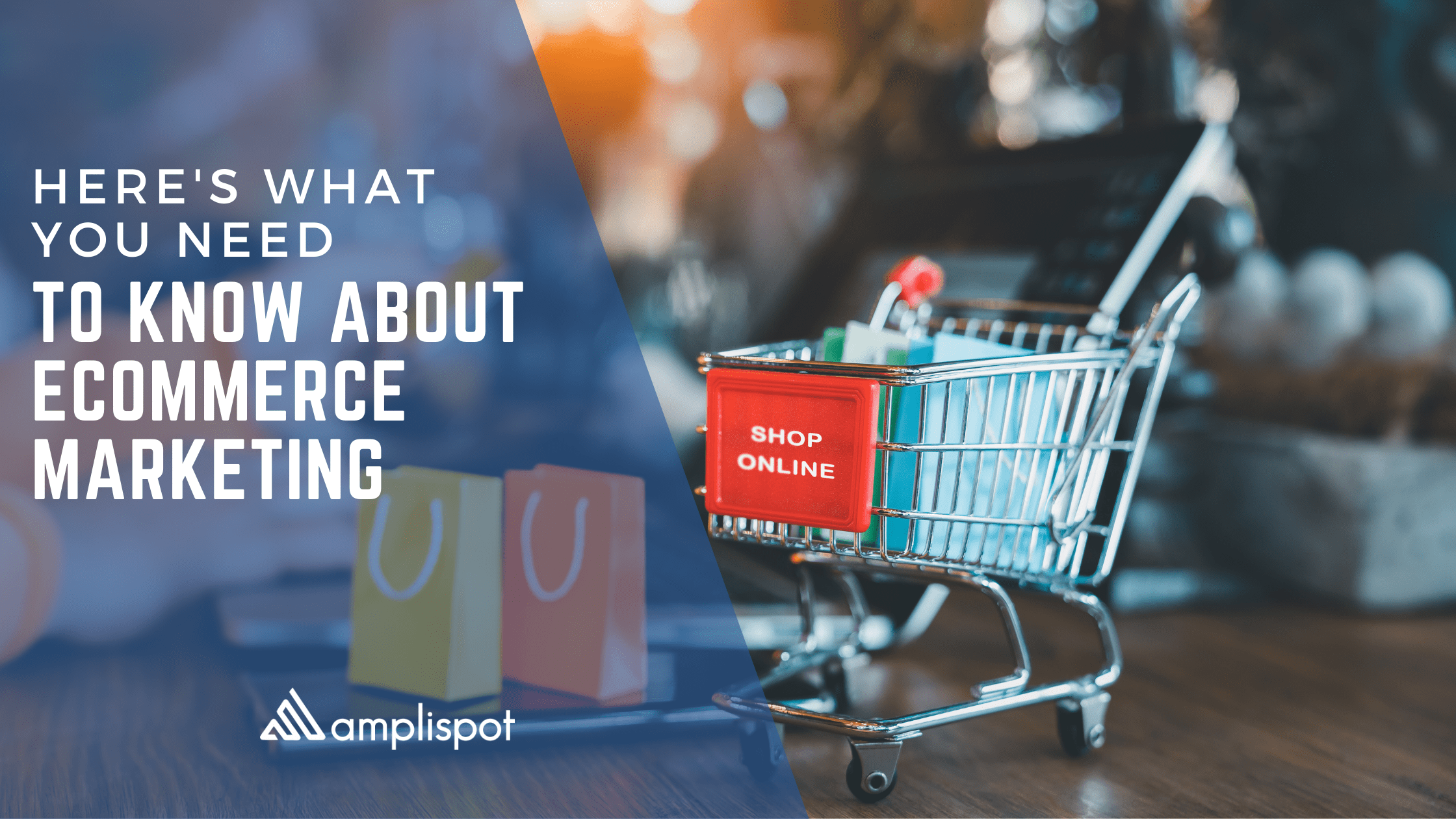With virtually every marketing effort now conducted online, it may be difficult to tell apart the many sorts of digital marketing tools utilized today.
Take ecommerce marketing, for example — what is it and how does it compare to social media, content, search engine, and email marketing?
Ecommerce and digital marketing are not mutually exclusive. Ecommerce sites may utilize all of the previously mentioned digital channels to market a product and expand their business.
This ecommerce marketing guide will go through all of today’s digital media.
What is ecommerce marketing?
Ecommerce marketing is the process of raising consumer awareness and action for an organization that sells its products or services over the internet.
Ecommerce industry professionals may use social media, digital assets, search engines, and email marketing to attract consumers and facilitate purchases online.
Let’s take a look at the definition of ecommerce advertising and commerce marketing, as well as their relationship to marketing for an e-commerce firm, before we get into further detail about what ecommerce marketing is and how to develop your own strategy.
Ecommerce Advertising
Ecommerce advertising, like advertising in general, is a form of marketing. Ecommerce marketing, as with other forms of marketing, falls under the umbrella of ecommerce marketing. When you utilize them together, you have the capacity to reach your audience members more effectively and enhance brand recognition by improving conversions and awareness.
Ecommerce marketing, as defined earlier, is the process of raising awareness and prompting action regarding your product or service.
Meanwhile, ecommerce marketing and selling encompasses the many strategies for promoting your goods. These advertisements may take the form of banner ads, rich media advertising, or display advertisements in terms of internet or ecommerce marketing and selling.
The most important point to take away from this is that ecommerce advertising is a highly effective approach for promoting your product or service while developing your ecommerce marketing plan.
Let’s continue our in-depth discussion about ecommerce marketing.
Types of Ecommerce Marketing
Here are some of the most popular marketing channels and how you may use them to build an internet business.
Social Media Marketing
Today’s most popular social networks are used by organizations of all shapes and sizes to communicate with their target audiences and post material that will appeal to them.
As an ecommerce marketer, you may do the same as an SEO/SEM specialist, but your campaigns will look somewhat distinct and not every social network is a good match for your needs.
Because ecommerce sites are typically very visual, your performance on social media is based entirely on how effectively you utilize images to attract attention and visitors to your product pages.
Instagram is an excellent platform for ecommerce enterprises since it allows you to post sharp product pictures and expand the reach of your products beyond their purchase page.
You may take your social media posts a step farther by creating shoppable content, which is material that allows people to purchase right away. This might range from strategically placed display advertisements within a social feed to additional tags that direct visitors to a shopping basket. These techniques assist you in removing friction from the purchasing process.
Product reviews are common in an ecommerce environment, too. Using a Facebook Business Page to praise a product is an ideal fit for companies that already offer customer reviews on their website. We’ll look at product evaluations deeper later in this section.
Content Marketing
When you consider “content marketing,” you might imagine blogs and video marketing — content designed to assist your website’s search engine results page (SERP) and address sector-related inquiries. However, do you truly need articles and videos to sell a product on the internet? You certainly do.
Here are a few ideas for using content to advertise your ecommerce business.
Optimize your product page copy.
To maximize the number of sales, optimize your product pages for short, product-driven keywords that include the name of the item. If you sell wedding dresses, a search for “brown bridesmaid dress” is more likely to produce results like yours if you’ve incorporated that term on the page.
Also, make sure your page titles, headers, and image alt text mention the correct keywords so search engines know to direct customers to your ecommerce site for those terms.
Write relevant blog posts.
If you run an online wedding dress store, blogging about “how to plan a wedding” might appeal to everyone involved in wedding preparations, regardless of where they are in the planning process.
You may draw visitors into consideration by creating articles that persuade them to do so, such as “how to choose the ideal wedding dress,” and then convert them into leads, like a downloadable “wedding planning checklist.”
Create guest posts for external websites.
Guest posts may help you and your items get in front of interested people (often for free). Submitting guest articles will also assist you improve your ecommerce site’s domain authority, which will tell search engines that you have a trustworthy website.
You’ll need to look for sites that rank for terms relevant to your product. You may not have to write a full article every time. If a site has a relatable piece, offer to expand on it by linking to additional information, such as a video or an infographic, and providing a link to your own site.
Put product-related videos on YouTube.
When it comes to content marketing, whether you’re looking for how-to’s or industry news, there’s a good chance your target audience is somewhere in there. It’s also the second-largest search engine after Google. YouTube is where you’ll discover a huge captive audience if that’s what you’re searching for. To determine your themes, use particularly searched keyword phrases to create topics relevant to your product and helpful to your target audience.
This is also an excellent choice for instructional videos that demonstrate current clients how to utilize your product — these videos can show people how to use your product in the best manner possible, resulting in increased client happiness and sustainable connections with website visitors.
Include a FAQ section on your website.
If your audience is asking questions about your product, you should be the one to answer them. To attract visitors to your website, create a FAQ page on it with answers to high-volume, long-tail keyword queries. You’ll be generating both authority and traffic, which are both important elements of an effective ecommerce business.
Search Engine Marketing
Both search engine optimization (SEO) and sponsored advertising are part of online marketing. While SEO is dependent on your understanding of Google’s ranking algorithm to improve your content, SEM may include pay-per-click (PPC) campaigns, display campaigns, or product-specific ad campaigns (think Google Shopping), which allow you to purchase top spots on search engine results pages.
PPC ads on Google ensure that interested customers will be presented with a link to your page when they search for terms that are inside the scope of your campaign. However, since you’re paying Google each time a person clicks on your result, the return to you should be significant.
This is why ecommerce marketers frequently utilize Google AdWords to promote their product pages via PPC advertisements. When the searcher clicks on a paid result, the campaign places them in front of the company’s product, increasing the chance that they will make a purchase before leaving the business’s website.
Email Marketing
One of the oldest forms of digital marketing is email marketing, and believe it or not, it has a purpose in ecommerce marketing.
The best part about email marketing? It may be automated. Automation implies that you can set up a successful drip campaign for subscribers classed by interest or stage in the buyer’s journey, and let your email campaign do the work. It’s one less marketing strategy to worry about on your long list of duties.
Even so, it’s critical that you maintain your email list in good standing since it will help you gain trust from your leads. In today’s data-privacy obsessed world, not every commercial email is welcome in a user’s inbox. Ecommerce marketers must be cautious when and how they add website visitors to their mailing lists.
Here are two ways an ecommerce marketer can use email marketing.
1. Post-Purchase Follow Up
Sending a follow-up email a few days after the product is delivered keeps the conversation going and monitors consumers’ future interest in your product line if they have already purchased a product from your website – and agreed to receive emails from you during the checkout process.
A post-purchase follow-up also demonstrates that you care about them after the transaction, and that your firm has a vested interest in their success with your product. It gives you the chance to get feedback on their purchase experience, which helps you cut friction for future customers.
Lastly, consider giving them some helpful hints for this sort of email. For example, ask them to write a review of your product and/or view original content on how to use it (those YouTube videos you produced would be ideal here).
2. The Abandoned Shopping Cart
Emails to diagnose the problem and retain their business can make the difference between a purchase and a lost client, according to Shopify. We’ll go through ways to decrease shopping cart abandonment later in this chapter.
Consider sending a polite email to a website visitor who has not completed a transaction while they’re in your shopping cart, suggesting assistance, or reminding them to complete the checkout procedure.
Influencer Marketing
Influencer marketing focuses on individuals or companies that impact your target market. The term is frequently employed to describe Instagram accounts with a large number of followers, although it may also refer to a celebrity or social group that your target audience follows or belongs to.
Influencers create online communities made up of individuals who are well-known, liked, and trusted by their followers. As a result, they may easily generate exposure for your online product by making a recommendation or “sponsored post.”
Affiliate Marketing
Affiliate marketing is an effective strategy to market your goods or service online. 81% of companies use affiliate marketing, and ecommerce websites are particularly appealing targets. Affiliates are people or businesses who receive a commission for selling your products on the internet.
Affiliates, unlike most social media influencers, promote products by utilizing traditional (but effective) marketing methods. Paid advertisements, content marketing, and other techniques are frequently used to bring visitors to their sites on your product: it’s as if you have a team market for you.
Local Marketing
Local marketing, on the other hand, allows you to focus on the areas where most of your prospects dwell (if you have a large population of them in one location) and gives you an opportunity to reward potential consumers.
To find out where your leads are located, use tracking cookies. Then give potential consumers in the areas where you have warehouses or shipping centers a price reduction (or free delivery). The incentive might be all it takes to win a new client.
Ecommerce Marketing Tips
There are several ecommerce marketing methods beyond the ones we’ve already discussed that you may use to attract customers to your online store. Let’s look at some more innovative strategies for promoting your ecommerce company.
1. Use personalization.
Personalization has been credited with revenue increases of 6-10 percent by businesses that implement it. What is this elusive pill?
Finding ways to address your consumers in the marketing materials you already have is called personalization; tailoring your outputs to match the particular needs of your consumer is what it means.
This might be in the form of a prospect’s name in the subject line of an email, suggested content or products based on a visitor’s behavior, or even displaying smart content on a website if a user revisits for a second time or has progressed through their buyer’s path.
Personalization may help buyers move through their purchase process more quickly, rather than looking for what they need. Instead of searching for what they require, you place it right in front of them, making it simple for them to accomplish your intended action: buy.
2. Capitalize on user-generated content (UGC).
What if you could have your consumers market for you for free? That’s what user-generated content, or UGC, is all about. It’s about finding methods for your clients to advertise and share your company that are both cost-effective and beneficial to them.
This is beneficial in a variety of ways: 1) It generates traffic to your ecommerce shop, and 2) it creates a genuine following of individuals who are interested in what you have to offer.
Coca-Cola® made a fantastic job of it with their “Share a Coke” campaign, which featured personalized Coca® bottles inscribed with names.
Here are some ways to drive UGC:
- Customers can enter competitions, where your product must be displayed in some way, to win.
- Customers may also submit feedback about your product on review sites and use branded hashtags on social media.
3. Build a loyalty program.
A satisfied client is a repeat customer, and who doesn’t want to get repeat business? A loyalty program provides a incentive for a consumer to remain loyal to you by offering relevant offers and discounts. While creating a customer loyalty program takes some time and effort, it pays off in repeat business, UGC, recommendations, and retention.
When developing a loyalty program, there are a few factors to think about as an ecommerce company. Consider expanding the methods in which consumers can demonstrate their loyalty, whether it’s through repeat purchases, social media mentions, or sharing your content. Also consider how you will pay off their loyalty: whether it be with points, discount codes, or unique benefits
Generate Word-of-Mouth Marketing (WOMM)
One of the most powerful marketing tools available is word-of-mouth marketing. People trust advice from people who are like them, according to the theory behind it. As buyers become more skeptical about corporate marketing approaches, the importance of word-of-mouth marketing in your business becomes all the more apparent.
While providing a fantastic customer experience may help you generate this naturally, you can also encourage and even create forms of WOMM that are just as effective.
Reviews
Customer reviews serve to lessen distrust since they are written by individuals who are not invested in your company’s success – rather, they’re a real and often vicious assessment of your product and how it worked out for them.
Reviews are useful marketing tools since they frequently include references to your product and may often be used to sell for you. People consider, “If it worked for them, it could work for me, too.” Encourage your consumers to leave reviews as much as feasible, and that post-purchase email we discussed might be a good place to start.
Referral Marketing
A referral is when consumers request their friends, relatives, and coworkers to buy from you. Sure, this may happen naturally if they truly like your product, but a referral program can help it to occur more often.
In exchange for something of value (e.g. a discount, money, or free gift) that you may give to either your new customer, your existing customer, or both, ask your customers to refer others. Dropbox does an excellent job of this; after you’ve referred a friend to join up, you get more cloud storage space for free.
Testimonials
Customer testimonials are a fantastic method to share how wonderful your product is. Testimonials, as the name implies, are composed of testimonies from customers.
If you have an ecommerce business, you should concentrate on aspects of the buying process, customer support, and frictionless delivery and installation procedures for your testimonial interviews.
Case Studies
Case studies are used in marketing to showcase customers’ triumphs in a way that pushes prospects over the edge. They should be connected to your buyer persona, so you should interview consumers who represent your target demographic. Case study best practice is to start by showing how a customer’s life was before your product and then how it has improved since.
4. Invest in live chat
Live chatbots — have you heard about them? They’re one of two options for using a live chat campaign. You may have a live person on staff to talk with potential consumers who visit your store, depending on your company’s size.
Live chat is a fantastic way to drive conversions and build goodwill. People are more likely to purchase from a store that has live chat since it offers them with answers immediately and when they’re in the checkout process, they can dispute any objections before making a purchase to reduce the chances of buyer’s remorse.
5. Cater to the shopping cart
We spoke about the reasons why consumers abandon their carts in the previous section, and a lot of it has to do with trust in your company, product, or delivery system. You must give clients every reason to want to buy from you without hesitation by addressing their concerns head-on.
Some ways to mitigate shopping cart abandonment are:
- Money-back guarantees
- Superior delivery options
- A simple return policy
- Immediate access to customer support
6. Implement a responsive website design.
No matter which aspect of your ecommerce plan you’re working on, it should be mobile-friendly. Your ecommerce marketing methods will be viewable and readily portable from any device (for example, laptop, smartphone, iPad or tablet).
In today’s digital world, where consumers are constantly on the go and surfing the web and shopping online from a variety of locations, your content will be simple to read and easy to navigate for everyone. (For some examples of successful responsive web design, check out this post.)
Ecommerce Marketing Strategy
Let’s put everything we’ve learned about ecommerce marketing together to create a strong marketing plan for your online business.
Set goals based on industry benchmarks.
There are certain standards you may use to measure your objectives against — these are industry standards.
Analyze how many page views, click-through rates, conversion rates, and customer acquisition costs your company has as well as compare them to those of your competitors.
Break down your strategy into small tactics.
There are numerous alternative strategies to take while developing a marketing plan for your online store, as we previously outlined. It may be tempting to pursue every one of them, but doing so is unlikely to be successful at any of them.
We recommend that you start by focusing on a few key strategies that you feel will have the most impact and are the most practical for you, and then develop action items for each.
Let’s assume you decided to concentrate on a paid strategy for getting consumers to your store. Set up a Google Ads account, calculate your ad spend, create an ad group based on your target keywords, and check your account daily are just a few of the things you’d have to do.
This may appear to be oversimplified; that is because it should be. You don’t want to get caught up in searching for the next “amazing ecommerce strategy” without making sure it’s working for you.
Delight your new and long-term customers.
Marketing doesn’t end once a sale is completed. You should continue to interact, nurture, and delight your existing customers.
This way, you’ll be encouraging your clients’ long-term success and increasing loyalty. It will also encourage your leads and target audience members to tell others about their great experiences via cause research, reviews, testimonials, and word of mouth.
Conclusion
Ecommerce marketing is essential for success in the online marketplace. By understanding the basics of how ecommerce marketing works and what needs to be done to create a successful plan, you’re well on your way to increased profits and a thriving business.
There you have it – everything you need to know about ecommerce marketing! Implementing these concepts will help your business reach new heights and attract more customers. Remember to focus on your goals and target audience, delight your customers, and measure your progress along the way. With careful planning and execution, you’re sure to see positive results from your ecommerce marketing efforts.






